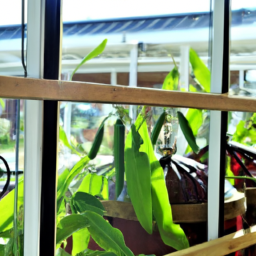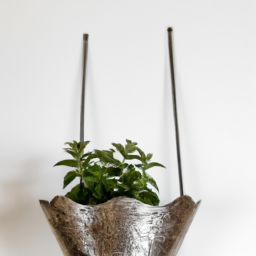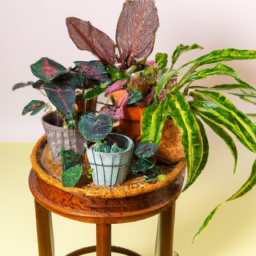
Are you looking to add a touch of nature to your indoor space? Container gardening might just be the perfect solution for you! The art of container gardening involves creating stunning indoor plant displays that not only bring life and beauty to your home but also allow you to showcase your creativity. Whether you have a green thumb or are a beginner in the world of gardening, this blog post will guide you through the process of creating captivating indoor plant displays using containers. Get ready to transform your living space into a lush oasis with the art of container gardening!
The Benefits of Container Gardening: Enhancing Indoor Spaces with Plants
Container gardening is a wonderful way to bring the beauty of nature indoors and create stunning displays of plants in your home. Whether you have a small apartment or a spacious house, container gardening allows you to add a touch of greenery and life to any room. In this guide, we will explore the art of container gardening and how it can enhance your indoor spaces.
1. Creating a Tranquil Environment
Indoor spaces can often feel sterile and lacking in natural elements. Container gardening provides an opportunity to transform your home into a tranquil oasis. By carefully selecting the right plants and containers, you can create a soothing atmosphere that promotes relaxation and reduces stress.
Choose plants with calming qualities, such as lavender or jasmine, and place them in containers that complement your interior design. Consider using decorative pots or repurposing unique items as planters to add a personal touch to your indoor garden.
In addition to the visual appeal, plants also improve air quality by absorbing carbon dioxide and releasing oxygen. This natural air purification can make your indoor spaces feel fresher and more invigorating.
2. Maximizing Limited Space
One of the greatest advantages of container gardening is its versatility in small spaces. Whether you live in a compact apartment or have limited outdoor areas, you can still enjoy the benefits of gardening by utilizing containers.
Vertical gardening is an excellent technique for maximizing limited space. By using hanging baskets or wall-mounted planters, you can create a lush green wall that adds depth and visual interest to your indoor spaces. Additionally, stacking containers or using tiered shelving can make efficient use of vertical space.
Furthermore, container gardening allows you to bring plants indoors during colder months or extreme weather conditions. This flexibility ensures that your plants thrive all year round, regardless of the outdoor climate.
3. Expressing Creativity
Container gardening is not just about the plants; it is an art form that allows you to express your creativity. With a wide variety of plants, containers, and decorative elements available, you can design unique and stunning displays that reflect your personal style.
Experiment with different plant combinations, textures, and colors to create visually appealing arrangements. Consider incorporating trailing plants for added drama or mixing different heights to create a sense of balance and harmony.
Don’t be afraid to think outside the box when choosing containers. Upcycled items such as old teapots, vintage suitcases, or even a pair of rain boots can add a whimsical touch to your indoor garden. Let your imagination run wild and create a container garden that truly showcases your individuality.
In conclusion, container gardening offers numerous benefits for enhancing indoor spaces with plants. It brings nature indoors, creates a tranquil environment, maximizes limited space, and allows for creative expression. So, why not embark on the journey of container gardening and transform your home into a breathtaking sanctuary?
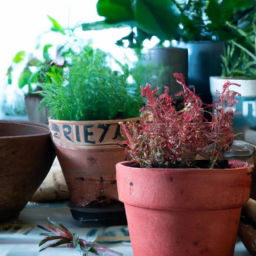
Choosing the Right Containers for Indoor Plant Displays: Size, Material, and Aesthetics
Introduction
Welcome to the wonderful world of container gardening! Whether you have a green thumb or are just starting your gardening journey, creating stunning indoor plant displays can bring life and beauty to any space. One of the key aspects to consider when embarking on this artistic endeavor is choosing the right containers for your indoor plants. In this guide, we will explore the importance of size, material, and aesthetics when selecting containers, ensuring your plants thrive in style.
Size Matters
When it comes to container gardening, size matters more than you might think. The size of your container directly impacts the growth and overall health of your plants. Too small of a container can restrict root growth and lead to stunted plants, while a container that is too large may cause overwatering and root rot.
Consider the mature size of the plant you intend to grow and choose a container that provides ample space for its roots to spread. A general rule of thumb is to select a container that is approximately one-third larger than the plant’s root ball. This allows room for growth while still providing a cozy environment for your plant.
Additionally, take into account the space where you plan to display your indoor plant. If you have limited space, opt for smaller containers that can be placed on shelves or countertops. On the other hand, if you have a spacious area, larger containers can make a bold statement and become a focal point in the room.
Material Matters
Choosing the right material for your container is not only a matter of aesthetics but also plays a crucial role in the overall health of your indoor plants. Different materials have varying levels of water retention, insulation properties, and durability. Let’s explore some popular container materials:
Terra Cotta
Terra cotta containers are a classic choice for indoor plant displays. They are known for their porous nature, allowing air and moisture to pass through the walls of the container. This promotes healthy root growth and prevents waterlogging. However, keep in mind that terra cotta containers tend to dry out more quickly, requiring more frequent watering.
Plastic
Plastic containers are lightweight, affordable, and come in a variety of shapes and sizes. They are an excellent choice for beginners or those who prefer low-maintenance gardening. Plastic containers retain moisture better than terra cotta, reducing the frequency of watering. However, they may not provide as much breathability, so be cautious not to overwater your plants.
Ceramic
Ceramic containers are known for their aesthetic appeal and versatility. They come in various colors, patterns, and textures, allowing you to find the perfect match for your interior decor. Ceramic containers tend to retain moisture well and provide good insulation for the roots. However, they can be heavy and may require additional care to prevent waterlogging.
Aesthetics Matter
Container gardening is not just about nurturing plants; it’s also an art form that allows you to express your creativity and enhance the visual appeal of your space. Consider the aesthetics of your indoor plant displays when selecting containers:
Matching or Contrasting
You can choose containers that match the color scheme and style of your room, creating a harmonious and cohesive look. On the other hand, contrasting containers can add a pop of color and create visual interest. Experiment with different combinations and let your personal style shine through.
Shapes and Sizes
Containers come in a wide range of shapes and sizes, from traditional round pots to sleek rectangular planters. Consider the overall design of your space and the plants you intend to grow. Tall, narrow containers can add height and drama, while shallow, wide containers are perfect for cascading plants.
Textures and Patterns
Don’t be afraid to incorporate containers with interesting textures and patterns. Ribbed, glazed, or even hand-painted containers can elevate the visual appeal of your indoor plant displays. Just ensure that the texture and pattern do not overpower the beauty of the plants themselves.
Conclusion
Choosing the right containers for your indoor plant displays is an essential step in creating stunning and thriving green spaces within your home. Remember to consider the size of the container in relation to your plant’s growth, select materials that promote healthy root development, and let your creativity shine through the aesthetics of your chosen containers. With these tips in mind, you are well on your way to mastering the art of container gardening and creating captivating indoor plant displays that bring joy and beauty to your surroundings.
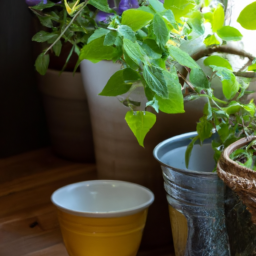
Essential Tips for Creating Stunning Indoor Plant Displays: Plant Selection, Placement, and Maintenance
Welcome to the world of container gardening! Whether you are a seasoned gardener or just starting out, creating stunning indoor plant displays can be a fulfilling and rewarding experience. In this guide, we will explore the art of container gardening and provide you with essential tips to help you create beautiful indoor plant displays. Let’s dive in!
1. Plant Selection
When it comes to creating stunning indoor plant displays, plant selection is key. Consider the following factors when choosing plants for your containers:
Light Requirements: Different plants have different light requirements. Some thrive in bright, direct sunlight, while others prefer indirect or low light conditions. Assess the lighting conditions in your home and choose plants accordingly.
Size and Growth Habit: Take into account the mature size and growth habit of the plants you choose. Ensure that they are suitable for the size of your containers and won’t outgrow them too quickly.
Watering Needs: Some plants require more frequent watering, while others prefer drier conditions. Consider your watering habits and choose plants that align with them.
Visual Appeal: Select plants with a variety of textures, colors, and shapes to create visually interesting displays. Mix tall, upright plants with trailing ones to add depth and dimension to your arrangements.
2. Placement
Proper placement of your indoor plant displays is crucial for their health and visual impact. Consider the following tips:
Light Levels: Place your plants in areas that provide the right amount of light for their specific needs. Avoid placing light-sensitive plants in direct sunlight, as it can scorch their leaves.
Room Temperature: Most indoor plants thrive in temperatures between 60-75°F (15-24°C). Avoid placing them near drafty windows or heating/cooling vents, as extreme temperature fluctuations can stress the plants.
Adequate Air Circulation: Ensure that there is enough air circulation around your plants to prevent the buildup of moisture, which can lead to fungal diseases. Avoid overcrowding your containers and provide enough space between them.
3. Maintenance
Regular maintenance is essential to keep your indoor plant displays looking stunning. Follow these tips:
Watering: Water your plants thoroughly but avoid overwatering. Check the moisture level in the soil by sticking your finger about an inch deep. If it feels dry, it’s time to water. Adjust the frequency of watering based on the specific needs of your plants.
Fertilizing: Feed your plants with a balanced, water-soluble fertilizer every 2-4 weeks during the growing season. Follow the instructions on the fertilizer package for the correct dosage.
Pruning and Grooming: Remove dead or yellowing leaves regularly to maintain the overall appearance of your plant displays. Prune back leggy growth to encourage bushier, more compact growth.
Pest Control: Keep an eye out for common indoor plant pests like aphids, spider mites, and mealybugs. If you notice any signs of infestation, treat the affected plants immediately using organic or chemical pest control methods.
By following these essential tips for creating stunning indoor plant displays, you can transform your living spaces into green oases of beauty and tranquility. Experiment with different plant combinations, containers, and arrangements to find your unique style. Happy gardening!
Let’s wrap up what we learned
Container gardening is a fantastic way to bring the beauty of nature indoors and create stunning plant displays that can transform any space. Whether you have a small apartment or a spacious home, you can easily create your own indoor garden with just a few containers and some greenery. The art of container gardening lies in the careful selection of plants, the arrangement of containers, and the overall design of the display.
To start, choose a variety of plants that thrive indoors and complement each other in terms of size, color, and texture. Consider plants with different heights and shapes to create visual interest. Next, select containers that not only match your style but also provide adequate drainage for the plants. Mixing and matching containers of various sizes and materials can add depth and character to your display. Once you have your plants and containers, it’s time to arrange them. Experiment with different layouts, placing taller plants at the back and shorter ones in front, or clustering plants of similar colors together. Don’t be afraid to get creative and think outside the box – you can even incorporate unique items like vintage teacups or repurposed glass jars as containers. Finally, pay attention to the overall design of your indoor garden. Consider the surrounding decor and choose a color scheme that complements the space. Add decorative elements like pebbles, moss, or small figurines to enhance the visual appeal. With a little bit of creativity and some green thumbs, you can create stunning indoor plant displays that bring life and beauty to your home.
Here are some questions from our readers:
Q1: What is container gardening?
A1: Container gardening is a method of growing plants in containers or pots instead of planting them directly in the ground. It allows you to create beautiful indoor plant displays by using various types of containers and choosing plants that thrive in indoor environments.
Q2: What are the benefits of container gardening?
A2: Container gardening offers several benefits. It allows you to have a garden even if you don’t have a yard or outdoor space. It’s also a great option for urban dwellers or those with limited mobility. Container gardens are portable, making it easy to rearrange or move them around. Additionally, they provide better control over soil quality, drainage, and sunlight exposure.
Q3: How do I choose the right container for my indoor plants?
A3: When selecting a container for your indoor plants, consider the size, material, and drainage. Choose a container that is appropriate for the size of your plant, allowing room for growth. Opt for containers made of materials like ceramic, clay, or plastic, which are durable and provide good insulation. Ensure the container has drainage holes to prevent waterlogging and promote healthy root growth.
Q4: What types of plants are suitable for indoor container gardening?
A4: Many plants thrive in indoor container gardens. Some popular choices include herbs like basil, mint, and parsley, flowering plants like orchids, African violets, and begonias, and foliage plants like pothos, spider plants, and ferns. Consider the lighting conditions in your home and choose plants that can thrive in low-light or bright, indirect light environments.
Q5: How do I care for my indoor container garden?
A5: To care for your indoor container garden, ensure you provide adequate water, light, and nutrients. Water your plants when the top inch of soil feels dry, but avoid overwatering. Place your containers in areas where they can receive the right amount of light based on the plant’s requirements. Fertilize your plants regularly using a balanced indoor plant fertilizer. Additionally, monitor your plants for pests and diseases, and take appropriate measures to keep them healthy.
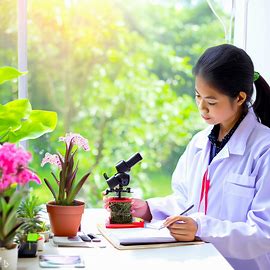
Lisa Chen is a seasoned indoor gardening expert and the author of several bestselling books on the topic. With a background in horticulture and urban farming, Lisa is dedicated to helping urban dwellers embrace the joys of cultivating green spaces indoors. Her detailed guides and hands-on tips empower readers to transform their living spaces into thriving plant sanctuaries.

